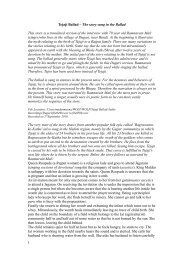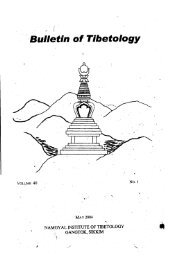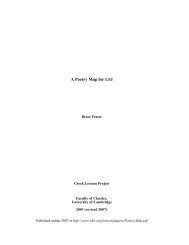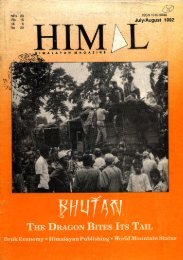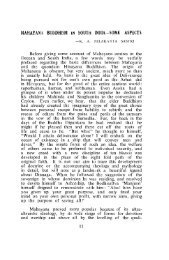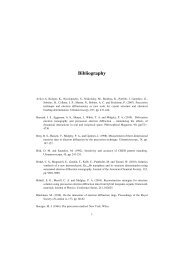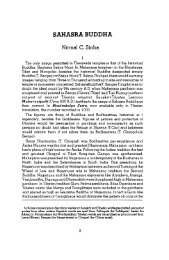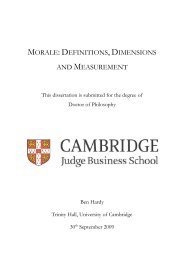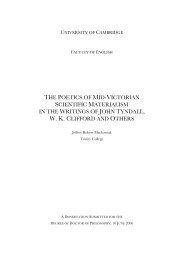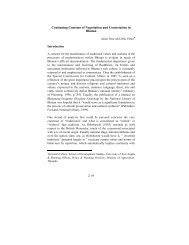The Crusades, the Genoese and the Latin East - DSpace at ...
The Crusades, the Genoese and the Latin East - DSpace at ...
The Crusades, the Genoese and the Latin East - DSpace at ...
You also want an ePaper? Increase the reach of your titles
YUMPU automatically turns print PDFs into web optimized ePapers that Google loves.
transition marked by <strong>the</strong> Third Crusade. ' 17 Indeed, <strong>the</strong> Third Crusade contributed to <strong>the</strong> shape of<br />
many of <strong>the</strong> characteristics of <strong>the</strong> future crusades; it structurally embedded many fe<strong>at</strong>ures of <strong>the</strong><br />
nautical crusades while beque<strong>at</strong>hing <strong>the</strong>m some insidious p<strong>at</strong>terns. <strong>The</strong> dependence on naval<br />
transport<strong>at</strong>ion meant th<strong>at</strong> embark<strong>at</strong>ion could only occur within a limited period, during <strong>the</strong> spring<br />
season. <strong>The</strong> Third <strong>and</strong> Fourth <strong>Crusades</strong> followed <strong>the</strong> long established naval <strong>and</strong> commercial<br />
experience of <strong>the</strong> Venetians <strong>and</strong> <strong>Genoese</strong> <strong>and</strong> <strong>the</strong>refore chose St Peter's day, <strong>at</strong> <strong>the</strong> end of June<br />
for <strong>the</strong>ir embark<strong>at</strong>ion. Naval expeditions during <strong>the</strong> winter were avoided whenever possible, as<br />
John Pryor explains, storms <strong>and</strong> `dangerous squally conditions cre<strong>at</strong>ed in winter by localised<br />
meteorological phenomena... because of <strong>the</strong> hazards caused by reduced visibility. '118<br />
Consequently, <strong>the</strong> embark<strong>at</strong>ion d<strong>at</strong>e was set as early as possible in <strong>the</strong> spring, allowing enough<br />
time for <strong>the</strong> contingents to ga<strong>the</strong>r in <strong>the</strong> western-Mediterranean <strong>and</strong> send troops into b<strong>at</strong>tle in <strong>the</strong><br />
east.<br />
<strong>The</strong> dependence on <strong>the</strong> Italian navies <strong>and</strong> <strong>the</strong> dealing with merchants <strong>and</strong> shipowners<br />
affected <strong>the</strong> mindset of <strong>the</strong> crusaders. When <strong>the</strong> French knights approached Genoa for assistance<br />
in shipping <strong>the</strong>m to <strong>the</strong> Holy L<strong>and</strong>, <strong>the</strong>y were introduced to its commercial, maritime <strong>and</strong> most<br />
importantly to its legal way of thinking. In <strong>the</strong> <strong>Genoese</strong> mind, freighting crusaders was not<br />
dissimilar to shipping o<strong>the</strong>r goods, <strong>and</strong> thus required a similar legal contract-119 <strong>The</strong> long-term<br />
effect of <strong>the</strong> contracts <strong>and</strong> regul<strong>at</strong>ions for <strong>the</strong> Third Crusade was vast. It marked a major step on<br />
<strong>the</strong> way to fur<strong>the</strong>r institutionalising <strong>the</strong> crusades. By <strong>the</strong> time of <strong>the</strong> Fourth Crusade, it was taken<br />
for granted th<strong>at</strong> a transport<strong>at</strong>ion contract needed signing. But <strong>the</strong> transmission of ideas <strong>and</strong><br />
actions is evident in many o<strong>the</strong>r details of <strong>the</strong> arrangements. Calcul<strong>at</strong>ion of <strong>the</strong> costs of <strong>the</strong><br />
crusades was determined in <strong>the</strong> same manner: a charge per unit of a knight with his two squires<br />
<strong>and</strong> two horses. This formula must have been a result of previous experience of <strong>the</strong> Italians in <strong>the</strong><br />
shipping of troops. However <strong>the</strong> changes th<strong>at</strong> occurred in <strong>the</strong> contracts of <strong>the</strong> following crusades<br />
suggest a learning process <strong>and</strong> an evolution of <strong>the</strong> organis<strong>at</strong>ion of <strong>the</strong> crusades. On <strong>the</strong> eve of <strong>the</strong><br />
Fourth Crusade, <strong>the</strong> number of horses taken was reduced by half to only one horse per knight.<br />
<strong>The</strong> total cost, however, increased by thirty percent. <strong>The</strong> high fee, coupled with wrong estim<strong>at</strong>ion<br />
of <strong>the</strong> needs, were <strong>the</strong> leading reasons th<strong>at</strong> <strong>the</strong> Fourth Crusade was a financial disaster for its<br />
117<br />
Jean Richard, 'Le transport outre-mer des croises et des p8lerins', pp. 28-29.<br />
118<br />
John H. Pryor, Geography, Technology <strong>and</strong> War, p. 87. See also Fern<strong>and</strong> Braudel, <strong>The</strong> Mediterranean<br />
<strong>and</strong> <strong>the</strong> Mediterranean World in <strong>the</strong> Age of Philip II, trans. Sian Reynolds (London, 1972), vol. 1, pp. 248-<br />
256.<br />
119<br />
On issues rel<strong>at</strong>ed to <strong>the</strong> shipping of crusaders see Jean Richard, 'Le transport outre-mer des croises et<br />
des p8lerins (XIIe-XVe siecles)', in Quellen und Darstellungen zur Hansische Geschichte, neue Folge, 34<br />
(1989), 2744; Michel Balard, `Les transports des occidentaux vers les colonies du Levant au Moyen Age',<br />
in Klaus Friedl<strong>and</strong> (ed. ), Maritime Aspects of Migr<strong>at</strong>ion (Cologne, 1989), pp. 14-5; Michel Moll<strong>at</strong>,<br />
'ProblPmes navals de 1'histoire des croisades' in Cahiers de Civiliz<strong>at</strong>ion MedievaleXe-Xlle-siecles, 10<br />
(1967), pp. 345-359.<br />
44



